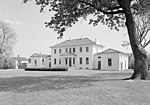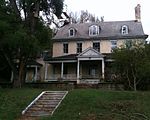Riversdale, is a five-part, large-scale late Georgian mansion with superior Federal interior, built between 1801 and 1807. Also known as Baltimore House, Calvert Mansion or Riversdale Mansion, it is located at 4811 Riverdale Road in Riverdale Park, Maryland, and is open to the public as a museum.
Once the manor house and centerpiece of a 739-acre (2.99 km2) slave plantation, Riversdale was built for Belgian émigré Henri Joseph Stier, Baron de Stier, who lived in the William Paca House in Annapolis, Maryland immediately prior to building Riversdale. Stier planned the house in 1801 to resemble his Belgian residence, the Chateau du Mick. Four years later, Stier returned to Belgium, leaving the unfinished Riversdale to be completed by his daughter, Rosalie Stier Calvert and her husband, George Calvert, the son of Benedict Swingate Calvert, who was a natural son of The 5th Baron Baltimore. Rosalie and George Calvert's son, Charles Benedict Calvert, established the Maryland Agricultural College, now the University of Maryland, College Park, on part of the Riversdale property.
While its design has been attributed to William Thornton, this is not supported by available evidence on Thornton's career. The house is architecturally significant as a well-preserved five-part Federal mansion, and historically important for its association with the Calverts, an important Maryland family. It was designated a National Historic Landmark in 1997.









